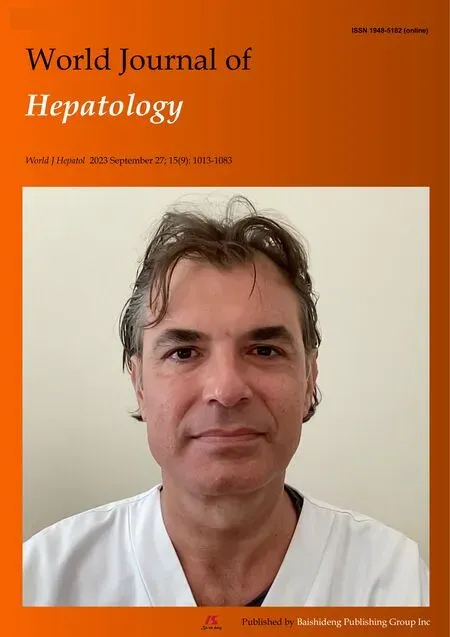Baseline metabolites could predict responders with hepatitis B virus-related liver fibrosis for entecavir or combined with FuzhengHuayu tablet
2023-10-19YunKaiDaiHaiNaFanKaiHuangXinSunZhiMinZhaoChengHaiLiu
Yun-Kai Dai,Hai-Na Fan,Kai Huang,Xin Sun,Zhi-Min Zhao,Cheng-Hai Liu
Abstract BACKGROUND After receiving entecavir or combined with FuzhengHuayu tablet (FZHY)treatment,some sufferers with hepatitis B virus (HBV)-related liver fibrosis could achieve a histological improvement while the others may fail to improve even worsen.Serum metabolomics at baseline in these patients who were effective in treatment remain unclear.AIM To explore baseline serum metabolites characteristics in responders.METHODS A total of 132 patients with HBV-related liver fibrosis and 18 volunteers as healthy controls were recruited.First,all subjects were divided into training set and validation set.Second,the included patients were subdivided into entecavir responders (E-R),entecavir no-responders (E-N),FZHY+entecavir responders (FR),and FZHY+entecavir no-responders (F-N) following the pathological histological changes after 48 wk’ treatments.Then,Serum samples of all subjects before treatment were tested by high performance liquid chromatographytandem mass spectrometry (LC-MS) high-performance LC-MS.Data processing was conducted using multivariate principal component analysis and orthogonal partial least squares discriminant analysis.Diagnostic tests of selected differential metabolites were used for Boruta analyses and logistic regression.RESULTS As for the intersection about differential metabolic pathways between the groups E-R vs E-N and F-R vs F-N,results showed that 4 pathways including linoleic acid metabolism,aminoacyl-tRNA biosynthesis,cyanoamino acid metabolism,alanine,aspartate and glutamate metabolism were screened out.As for the differential metabolites,these 7 intersected metabolites including hydroxypropionic acid,tyrosine,citric acid,taurochenodeoxycholic acid,benzoic acid,2-Furoic acid,and propionic acid were selected.CONCLUSION Our findings showed that 4 metabolic pathways and 7 differential metabolites had potential usefulness in clinical prediction of the response of entecavir or combined with FZHY on HBV fibrotic liver.
Key Words: Serum metabolomics;Differential metabolites;Therapeutic responders;Entecavir;FuzhengHuayu tablet;Hepatitis B virus-related liver fibrosis
INTRODUCTION
Liver fibrosis,characterized by the progressive and reversible accumulation of fibrillar extracellular matrix components in the liver,poses a significant threat to the physiological architecture of the liver and accounts for nearly half of all-cause mortality associated with various liver diseases worldwide[1-2].Among the numerous causes of acute and chronic liver diseases,hepatitis B virus (HBV) infection stands out as a prevalent culprit and a leading instigator of liver fibrosis[3].Epidemiological studies have revealed that more than 240 million individuals are afflicted by HBV infection[4].Given the insidious nature of chronic hepatitis B (CHB),it can swiftly advance to fibrosis,cirrhosis,or even hepatocellular carcinoma (HCC) if left unchecked[5].Hence,it is imperative to consider the use of antiviral agents in the treatment of HBV,with entecavir serving as a prominent representative.
In recent years,the study of liver fibrosis has consistently been a focal point of medical research[6].Serving as a reversible lesion,liver fibrosis acts as the intermediary stage between the development of chronic liver diseases and the progression to cirrhosis[7].Presently,effective treatments for cirrhosis remain limited,underscoring the significance of anti-liver fibrosis as a crucial therapeutic strategy.FuzhengHuayu tablet (FZHY),a novel traditional Chinese medicine(TCM) remedy,has gained widespread usage in clinical practice for the treatment of liver fibrosis and cirrhosis[8].Furthermore,our prior multi-center clinical investigation has substantiated that entecavir+FZHY therapy significantly enhances the histological reversal rate of CHB fibrosis[9].Nonetheless,approximately one-third of patients fail to exhibit a substantial histological response[10].Consequently,elucidating the biological characteristics of individuals who respond to entecavir or entecavir+FZHY will u.doubtedly contribute to the enhancement of precision therapy's therapeutic efficacy.
To date,no single biomarker or scoring system has achieved the ideal balance of sensitivity and specificity for the detection and characterization of liver fibrosis[11].While liver biopsy remains the gold standard for staging liver fibrosis,it is burdened by limitations such as invasiveness,sampling errors,and the potential for complications[12].Furthermore,this method lacks convenience in tracking the dynamic progression of liver fibrosis and assessing therapeutic outcomes.Fortunately,non-invasive diagnostic techniques for liver fibrosis,including transient elastography (Fibroscan),elastography,and diffusion-weighted magnetic resonance imaging,have made significant advancements and gained widespread clinical utility.However,these approaches are susceptible to interference from factors such as a patient’s body mass index (BMI),liver inflammation,or hepatocyte degeneration[13].
Metabolomics,an emerging field following in the footsteps of genomics,transcriptomics,and proteomics,represents a novel approach to systematically study changes in small-molecule metabolites produced by the body’s metabolism[14].Often referred to as the “end point” of the genome and proteome,metabolomics allows for the comprehensive analysis of various metabolites and their metabolic pathways in a population,offering high-throughput and modeling capabilities.Furthermore,metabolomics can unveil.downstream products of gene and protein expression within an organism,providing insight into all physiological processes within the body.Due to its close proximity to disease phenotypes,metabolomics is particularly well-suited for disease classification and biomarker discovery.In this study,we intend to employ high-performance liquid chromatography-mass spectrometry (HPLC-MS) and advanced multivariate statistical modeling to predict serum metabolite profiles associated with the effective reversal of HBV-related liver fibrosis induced by treatment with entecavir or entecavir+FZHY.This research holds profound theoretical and practical significance in preventing the progression of liver fibrosis to cirrhosis or HCC,thereby reducing the societal burden associated with these conditions.
MATERIALS AND METHODS
Patient selection
This is a cross-sectional study that encompasses multi-center ra.domized controlled clinical trials.We enrolled a total of 132 patients with HBV-related liver fibrosis,along with 18 healthy volunteers as controls,during the period from September 9,2014,to October 25,2018.The study comprised two distinct sets: A training set and a validation set.All participants were recruited from 20 hospitals across China and provided voluntary informed consent.The research protocol received ethical approval from the Ethics Committee of Shuguang Hospital Affiliated with Shanghai University of TCM (ethical approval number: 2014-331-27-01).The diagnostic criteria for HBV-related liver fibrosis were in accordance with the guidelines for the prevention and treatment of CHB (2019)[15].The primary focus of this study was on the progression of liver fibrosis,assessed primarily through liver histopathology using the Ishak scoring system as the indicator for therapeutic evaluation.The primary outcome measured was the proportion of patients demonstrating a 1-point improvement in liver fibrosis stage,as per the Ishak score,from baseline to 48 wk.Liver biopsies were performed both before and 48 wk after the initiation of combination TCM treatment,and the histopathological evaluation was independently conducted by three pathologists.Fibrosis regression was defined as a decrease in the Ishak score of 1 or greater[16].The final fibrotic scores were established based on consensus among two or more pathologists;any disagreements were resolved by a central pathologist.However,a detailed assessment of inflammation levels was not performed.For the noninvasive diagnosis and staging of liver fibrosis,aminotransferase-to-platelet ratio index (APRI)and fibrosis index based on the 4 factor (FIB-4) were primarily employed as adjunct diagnostic tools to assess the severity of liver fibrosis.Consequently,the two treatment groups were further subdivided into four subgroups: Entecavir responders (E-R),entecavir non-responders (E-N),FZHY+entecavir responders (F-R),and FZHY+entecavir nonresponders (F-N).Inclusion criteria for this study encompassed individuals aged 18 years or older who met the aforementioned diagnostic criteria.Exclusion criteria included the following: individuals with liver fibrosis not associated with HBV infection;those with cardio-cerebrovascular or infectious diseases or other digestive system disorders;pregnant or lactating women;and patients with poor compliance.
Sample collection
All subjects were asked to have normal regular diets and schedules on the day before blood collection,and venous blood was collected on an empty stomach the next morning.500 μL serum was centrifuged at 4 ℃ at 4000 r/min and stored in a-80 ℃ for later use.
Sample processing
The cryopreserved serum was thawed on ice-bath in case of degradation.25 μL of serum was added to a 96-well plate for the transferring to the Biomek 4000 workstation (Biomek 4000,Beckman Coulter,Inc.,Brea,CA,United States).120 μL of methanol was automatically added to each serum and vortexed for 5 min.The plate was centrifuged at 4000 g for half an hour and it was returned back to the workstation.30 μL of supernatant fluid was transferred to a clean 96-well plate,where each well was filled with 20 μL of freshly prepared derivative reagents.Then the plate was sealed for derivatization at 30 ℃ for an hour and the sample was diluted by 330 μL of ice-cold 50% methanol solution.Next,the plate was left at -20 ℃ for 20 min and centrifuged at 4 ℃ for half an hour.Finally,135 μL of supernatant fluid was taken to a new 96-well plate,which was sealed for liquid chromatography-tandem mass spectrometry (LC-MS) analysis.
Quality control analysis
All samples were mixed into one quality control sample for quality control.The quality control samples were analyzed 6 times and ra.domly respectively tested 2 times before,during and after analysis.The total ion flow chromatograms of the quality control samples were overlapped and the total principal component analysis (PCA) was performed.It would show good repeatability if the results of the quality control samples were close to each other.
Materials and reagents
Formic acid (Optima grade) was obtained from Sigma-Aldrich (St.Louis,MO,United States).Methanol (Optima LC-MS)and acetonitrile (Optima LC-MS) were purchased from Thermo-Fisher Scientific (FairLawn,NJ,United States).The experimental water was distilled water.
Instrument analysis platform
We used a ultra-performance liquid chromatography coupled to tandem mass spectrometry system (ACQUITY UPLCXevo TQ-S,Waters Corp.,Milford,MA,United States) in order to quantitate all targeted metabolites in this study.A briefly description of the optimized instrument settings can be shown in Supplementary Table 1.Meanwhile,the instrument performance optimization and routine maintenance were conducted every week.
LC-MS analysis
Extraction of ion flow chromatograms based on HPLC-MS.(1) Chromatographic elution gradient: The initial gradients were 5% solution B (acetonitrile+0.1% formic acid) and 95% solution A (distilled water+0.1% formic acid),whose elution time lasted 2-10 min.Meanwhile,solution B increased linearly to 95% for 5 min and then dropped back to 5%.The injection volume was 4 uL and the automatic sampler temperature was 4 ℃;and (2) mass spectrometry scanning mode:Positive and negative ions were used for detection by mass spectrometry.The ion scanning time was 0.03 s,the time interval was 0.02 s,and the data collection range was 50-100 m/z.
Screening and identification of potential metabolites
The data of group A and group B were analyzed by total PCA,then partial least squares discriminant analysis (PLS-DA)was used,and finally the supervised orthogonal PLS-DA (OPLS-DA) was used for modeling analysis.Variable importance in the projection (VIP) values (threshold > 1) based on the OPLS-DA model,combined withPvalue (P< 0.05)ofttest,were used to find metabolites which were differentially expressed.Potential metabolites were identified by searching online database (http://metlin.scripps.edu/) to compare the mass charge ratio or molecular mass of mass spectrometry.
Potential metabolite enrichment analysis and metabolic pathway analysis
Metabo-Analyst online analysis software (https://www.metaboanalyst.ca) and Kyoto Encyclopedia of Genes and Genomes databases (https://www.kegg.jp/) were used for metabolic pathway analysis and enrichment analysis of the identified potential metabolites so as to determine the metabolic pathways involved in the potential metabolites,and to evaluate the diagnostic performance of the potential metabolites enriched in pathways.
Diagnostic tests
In order to validate the applicability and stability of the selected differential metabolites,ra.dom forest (RF),Support vector machine (SVM) and Boruta analyses were conducted for each selected metabolite in sequence.Boruta analysis,the maximum number of runs with 1000,was an RF-based feature selection method that it selects key features with more significant distinguishing ability than ra.dom lag features.When provisional features were included,a secondary selection was made to determine whether certain metabolites with large fluctuations should be included in the selected features.
These differential metabolites used for subsequent model construction were modeled and predicted using logistic regression.After modeling,sensitivity and specificity values were calculated to evaluate the model effects through drawing the receiver operating characteristic curve.Meanwhile,the closer the area under the curve (AUC) value is to 1,the better the sensitivity,specificity and diagnostic abilities.The conventional AUC of metabolites with the value ≥ 0.75 indicated relatively good sensitivity and specificity.
Statistical analysis
Statistical analysis software packages in R studio (http://cran.r-project.org/) were performed for the statistical algorithms.All the included data were calculate with mean ± SD or median-interquartile range.The Mann-Whitney U test orttest was used for the statistical differences in pairwise comparison.Multivariate statistical modelings including PCA,PLS-DA,and OPLS-DA were used for the multi-class classification and identification of differently altered metabolites.Among these modelings,each spatial.dot in the K-dimensional space represented an individual sample with the samples color-coded based on grouping information.R2X and R2Y respectively represented the fraction of the variance of X matrix and Y matrix,while Q2Y represented the predictive accuracy of the model.Cumulative values of R2X and R2Y approaching 1.0,along with Q2Y greater than 0.2 (permutation test),indicated a model with a satisfactory predictive ability.Those variables with VIP greater than 1.0 are considered significantly different between classes.If multidimensional statistics cannot establish a robust discriminant model (such as uneven distribution of inter-group sample categories or large intra-group deviation),differential metabolites between the two groups would be acquired with the aid of univariate analysis.
RESULTS
Baseline clinical characteristics of participants
In the training set,there were 23 sufferers in each subgroup and 13 normal volunteers as control.In the validation set,there were 10 patients in each subgroup and 5 volunteers as control.Details of the baseline clinical characteristics of the two datasets can be found in Table 1.Specifically,there were no significant differences in the gender,age,BMI,alanine aminotransferase,aspartate aminotransferase,albumin (ALB),total bilirubin (TBIL),creatinine,prothrombin time,platelet count,alpha fetoprotein,FIB-4,aspartate APRI,Ishak score in the training set (P> 0.05).However,in thevalidation set,the serum ALB and TBIL levels significantly differed between the F-R and F-N patients (P< 0.05),but the other indexes were not statistically significant (P> 0.05).
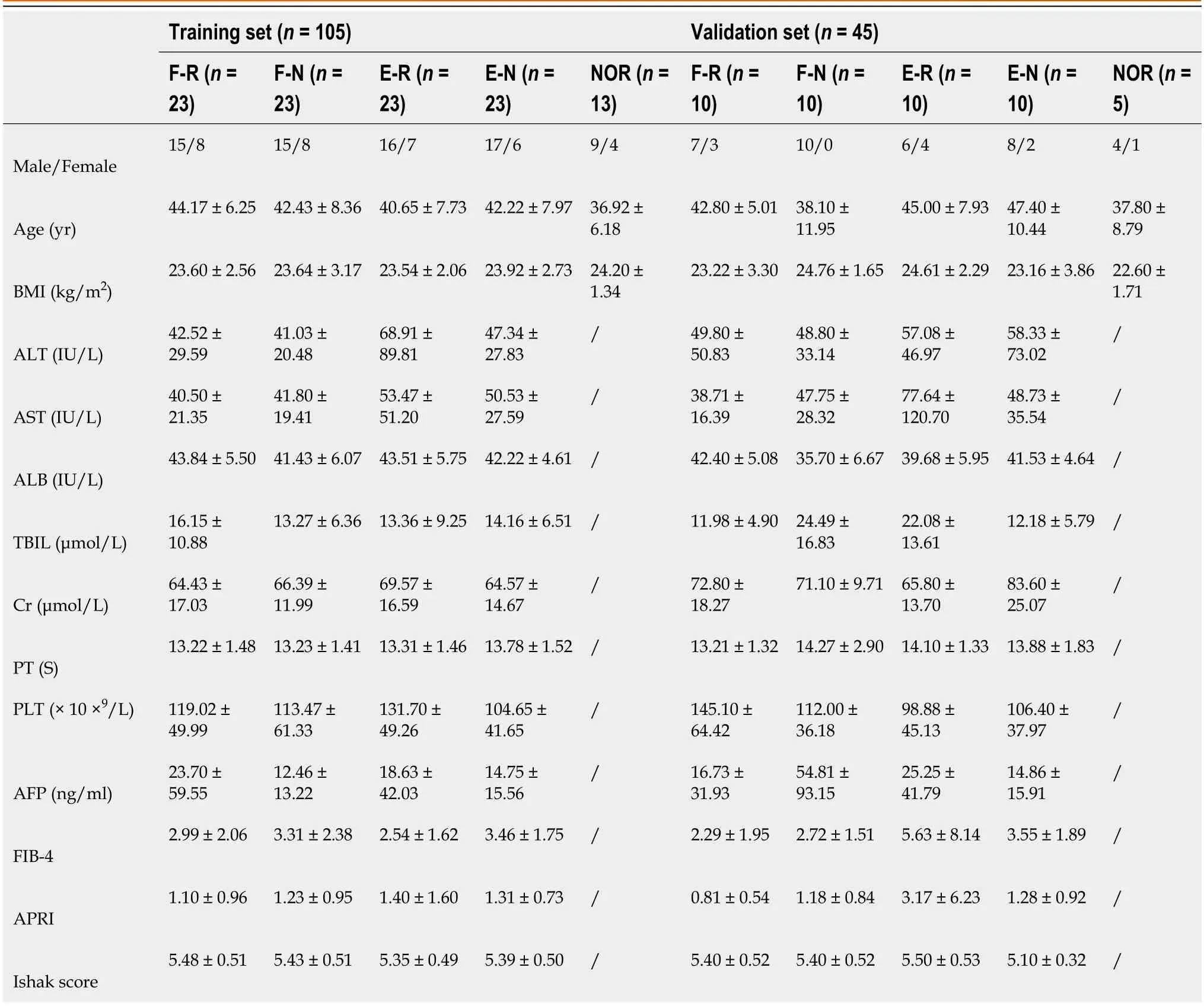
Table 1 Demographic and clinical data of patients and volunteers in training set and validation set
The pathological histological results of the liver biopsy
The obtained tissuesvialiver biopsy were fixed in 10% formalin and embedded in paraffin.Sections of each liver tissue were cut and stained using hematoxylin-eosin (HE) staining for histopathological analysis.Based on the HE staining results and Ishak score,staging of liver fibrosis was determined as F1 to F6[17].Briefly,F1: Some portal areas have fibrosis but no fibrous septum;F2: Many portal areas have fibrosis along with one fibrous septum;F3: Many portal areas have fibrosis along with two or three fibrous septa;F4: Portal areas have obvious portal-junction bridge fibrosis along with more than four fibrous septa;F5: Portal areas have obvious portal-junction bridge fibrosis or portal-central bridge fibrosis along with one to three pse.dolobuli and F6: More than three pse.dolobuli.Details of relevant figures can be found in Supplementary Figure 1.
Overall metabolomics analysis of serum samples
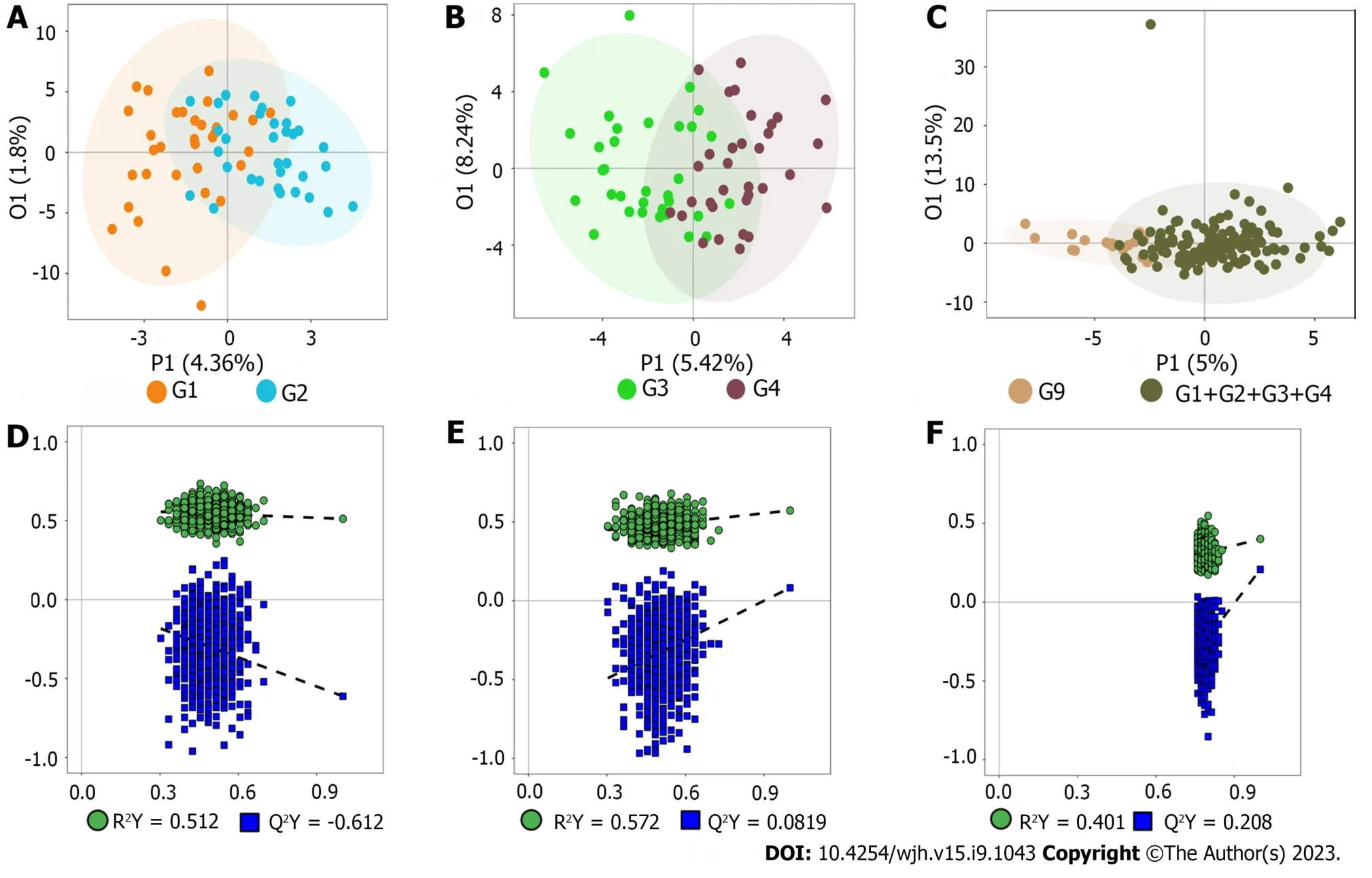
Figure 1 Orthogonal partial least squares discriminant analysis of all the metabolites. A: Score of entecavir responders (E-R) vs entecavir noresponders (E-N);B: Score of FuzhengHuayu tablet (FZHY)+entecavir responders (F-R) vs FZHY+entecavir no-responders (F-N);C: Score of patients vs volunteers;D: R2X and R2Y of E-R vs E-N;E: R2X and R2Y of F-R vs F-N;F: R2X and R2Y of patients vs volunteers.
Representative nuclear magnetic resonance spectra with targeted metabolites are exhibited in Supplementary Figure 2.The serum spectra included high-intensity signals from Maleic acid,Glycine (G1vsG2),dihomo-gamma-linolenic acid,arach.donic acid,hydroxypropionic acid,(G3vsG4),2-Furoic acid,2-Phenylpropionate,arach.donic acid,benzoic acid,butyric acid,aconitic acid,citric acid,dimethylglycine,glycochenodeoxycholic acid (GCDCA),homovanillic acid,hydrocinnamic acid,hydroxyphenyllactic acid,isocitric acid,tyrosine,phenyllactic acid,propionic acid,taurochenodeoxycholic acid (TCDCA),tricarboxylic acid (TCA) (G9vsG1-G4).Because all patients were suffered from HBV-related liver fibrosis in this study,statistical assessment by PCA indicated not clear separation in each group (E-RvsE-N;F-RvsF-N;patients vs volunteers) (Supplementary Figure 3).Besides,in order to exclude the possible confounding factors irrelevant to the group differences and to assess the statistical meaning of those signals,OPLS-DA was conducted and the result showed that the discrimination model could differentiate the two groups despite within a small overlap in one orthogonal component (Figure 1A-C).Moreover,as shown in Figure 1D-F,the models with R2(Y) of 0.512 (E-RvsE-N),0.572 (F-RvsF-N),0.401 (patientsvsvolunteers) suggested relatively good predictability and no potential over-fit.However,the models with Q2(Y) of -0.612 (E-RvsE-N),0.0819 (F-RvsF-N),and 0.208 (patientsvsvolunteers) indicated the potential risk of over-fit.
Serum metabolites relevant to responders and HBV-related liver fibrosis
Due to the possibility of potential risk of the over-fit in these models,differential metabolites between the two groups were acquired with the aid of univariate analysis instead of analysis together with the VIP values from the above OPLSDA model.Furthermore,in order to explore the applicability and stability of the distinctive models,serum samples from all the included patients and volunteers were collected and analyzed using the training set and validation set for the subsequent analyses.
In order to find out potential metabolites involving in responders and HBV-related liver fibrosis among the thousands of variables,a pairwise comparison in each group was conducted.According to the threshold value (P< 0.05 and |log2FC| ≥ 0,FC: Fold change),a total of 2 (E-RvsE-N),16 (F-RvsF-N) and 35 (patientsvsvolunteers) potential metabolites in the training set (Figure 2A-C) were obtained while a total of 8 (E-RvsE-N),7 (F-RvsF-N) and 23 (patientsvsvolunteers) potential metabolites in the validation set (Figure 2D-F) were acquired.
Selection of potential metabolites in different sets
By taking intersection and union set in terms of the aforementioned obtained unidimensional and multidimensional potential metabolites,these metabolites that may have biological significance can be selected on the basis of OPLS-DA(VIP > 1) and univariate (P< 0.05 and |log2FC| ≥ 0) analyses.A total of 53 potential metabolites in the training set and 38 potential metabolites in the validation set were obtained.Detailed information of these selected potential metabolites were shown in Table 2.The distribution of data for all the metabolites in each group can be found in Supplementary Figure 4.Furthermore,a heat map,together with Z-score,was used for analysis of these selected metabolites and the results suggested that the pairwise comparisons between the two groups could be separated no matter which data set was (Figure 3).

Figure 2 Volcano plot of serum metabolites.A: Volcano plot of entecavir responders (E-R) vs entecavir no-responders (E-N) (training set);B: Volcano plot of FuzhengHuayu tablet (FZHY)+entecavir responders (F-R) vs FZHY+entecavir no-responders (F-N) (training set);C: Volcano plot of patients vs volunteers (training set);D: Volcano plot of E-R vs E-N (validation set);E: Volcano plot of F-R vs F-N (validation set);F: Volcano plot of patients vs volunteers (validation set).
Metabolic pathways related to the selected metabolites in different sets
Both topological centrality (impact value > 0) and enrichment significance [-ln(p) > 2.99,namelyP< 0.05] were used to evaluate the analyses of enrichment and metabolic pathways for the selected potential metabolites.As shown in Figure 4,there were 2 pathways (butanoate metabolism,nicotinate and nicotinamide metabolism) (E-RvsE-N),1 pathway (fatty acid biosynthesis) (F-RvsF-N),and 11 pathways (primary bile acid biosynthesis,nitrogen metabolism,butanoate metabolism,aminoacyl-tRNA biosynthesis,cyanoamino acid metabolism,phenylalanine metabolism,glycine,serine and threonine metabolism,glyoxylate and dicarboxylate metabolism,citrate cycle (TCA cycle),thiamine metabolism,alanine,aspartate and glutamate metabolism) (patientsvsvolunteers) in the training set (Figure 4A-C);and there were 6 pathways(aminoacyl-tRNA biosynthesis,cyanoamino acid metabolism,nitrogen metabolism,linoleic acid metabolism,thiamine metabolism,alanine,aspartate and glutamate metabolism) (E-RvsE-N),5 pathways (nitrogen metabolism,aminoacyltRNA biosynthesis,cyanoamino acid metabolism,alanine,aspartate and glutamate metabolism,beta-alanine metabolism)(F-RvsF-N),and 6 pathways (phenylalanine metabolism,primary bile acid biosynthesis,TCA cycle,tyrosine metabolism,ubiquinone and other terpenoid-quinone biosynthesis,nitrogen metabolism) (patientsvsvolunteers) in the validation set(Figure 4D-F).
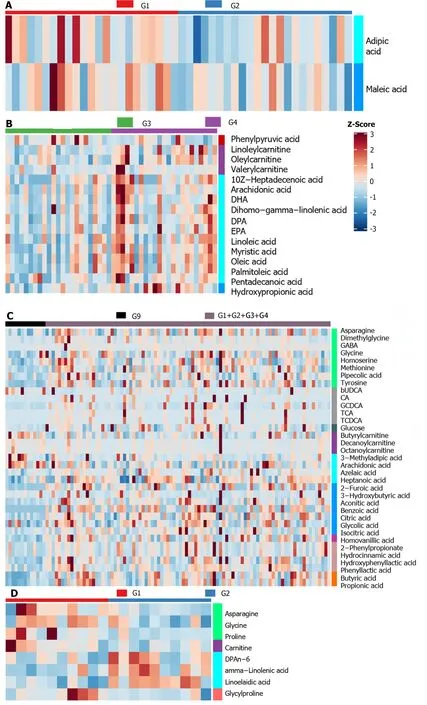

Figure 3 Heatmap of all the selected potential metabolites.A: Heatmap of entecavir responders (E-R) vs entecavir no-responders (E-N) (training set);B:Heatmap of FuzhengHuayu tablet (FZHY)+entecavir responders (F-R) vs FZHY+entecavir no-responders (F-N) (training set);C: Heatmap of patients vs volunteers(training set);D: Heatmap of E-R vs E-N (validation set);E: Heatmap of F-R vs F-N (validation set);F: Heatmap of patients vs volunteers (validation set).CA: Citric acid;GCDCA: Glycochenodeoxycholic acid;TCA: Tricarboxylic acid;TCDCA: Aurochenodeoxycholic acid;DHA: Docosahexaenoic acid;DPA: Docosapentaenoic acid;EPA: Eicosapentaenoic acid.
Selection of differential metabolites in different sets
In order to find differential metabolites from these selected potential metabolites,RF,SVM and Boruta analyses were conducted for each selected metabolite in sequence.And intersection of these potential metabolites in the three analyses can be found in Supplementary Figure 5.Specifically,there were Maleic acid and Adipic acid (E-RvsE-N),Hydroxypropionic acid,10Z-heptadecenoic acid,and linoleylcarnitine (F-RvsF-N),tyrosine,benzoic acid,2-Furoic acid,aconitic acid,and butyrylcarnitine (patientsvsvolunteers) in the training set while there were linoelaidic acid,gamma-linolenic acid,glycylproline,proline,asparagine,and carnitine (E-RvsE-N),hydroxypropionic acid,aspartic acid,dihomo-gammalinolenic acid,and tyrosine (F-RvsF-N),dimethylglycine,citric acid,GCDCA,and 2-phenylpropionate (patientsvsvolunteers) in the validation set.
In the results of Boruta analysis (Figure 5),the metabolites marked as confirmed are the differential metabolites obtained by the final screening for subsequent model construction.As shown in Figure 5A-C,in addition to the above intersection metabolites,there were arach.donic acid,oleylcarnitine,and.docosahexaenoic acid (F-RvsF-N),butyric acid,TCDCA,arach.donic acid,citric acid,and propionic acid (patientsvsvolunteers) confirmed in the training set.As shown in Figure 5D-F,in addition to the above intersection metabolites,there were TCDCA,benzoic acid,tyrosine,2-Furoic acid,butyric acid,TCA,isocitric acid,hydrocinnamic acid,and propionic acid (patientsvsvolunteers) confirmed in the validation set.
Evaluation of model effects in different sets
In the training set,there were good sensitivity and specificity with the AUC value of 0.851 (F-RvsF-N) and 0.985 (patientsvsvolunteers) except for 0.733 (E-RvsE-N) (Figure 6A-C).In the validation set,there were good sensitivity and specificity with the AUC value of 1 (E-RvsE-N,patientsvsvolunteers) and 0.94 (F-RvsF-N) (Figure 6D-F).On the whole,the above AUC values of the two sets indicated good diagnostic capability in this study.

Figure 4 Bubbleplot of the selected metabolites pathways.A: Bubbleplot of entecavir responders (E-R) vs entecavir no-responders (E-N) (training set);B:Bubbleplot of FuzhengHuayu tablet (FZHY)+entecavir responders (F-R) vs FZHY+entecavir no-responders (F-N) (training set);C: Bubbleplot of patients vs volunteers (training set);D: Bubbleplot of E-R vs E-N (validation set);E: Bubbleplot of F-R vs F-N (validation set);F: Bubbleplot of patients vs volunteers (validation set).TCA: Tricarboxylic acid.
DISCUSSION
With the global prevalence of HBV-related liver fibrosis on the rise,precise targeting of the population that responds to entecavir or entecavir+FZHY is of paramount importance for improving clinical efficacy through precision treatment.Metabolomics serves as a valuable tool for biomarker discovery[18].In this study,we employed HPLC-MS and advanced multivariate statistical modeling to predict the serum differential metabolites associated with interventions effectively reversing HBV-related liver fibrosis.Our findings revealed the involvement of 7 metabolic pathways (E-RvsE-N),including linoleic acid metabolism,aminoacyl-tRNA biosynthesis,cyanoamino acid metabolism,alanine,aspartate,and glutamate metabolism,nitrogen metabolism,butanoate metabolism,and nicotinate and nicotinamide metabolism.Similarly,7 metabolic pathways (F-RvsF-N) were identified,encompassing linoleic acid metabolism,aminoacyl-tRNA biosynthesis,cyanoamino acid metabolism,alanine,aspartate,and glutamate metabolism,nitrogen metabolism,betaalanine metabolism,and fatty acid biosynthesis.Furthermore,3 metabolic pathways (patientsvs.volunteers) were noted,which included nitrogen metabolism,primary bile acid biosynthesis,and the TCA cycle.Regarding the intersection of differential metabolic pathways between the E-RvsE-N and F-RvsF-N groups,our study highlighted 4 common pathways: Linoleic acid metabolism,aminoacyl-tRNA biosynthesis,cyanoamino acid metabolism,and alanine,aspartate,and glutamate metabolism.
Regarding linoleic acid metabolism,a study suggested an inverse association between dietary linoleic acid intake and the risk of significant liver fibrosis,particularly emphasizing the ratio of unsaturated to saturated fatty acids[19].Another clinical investigation demonstrated that specific alterations in linoleic acid metabolites could differentiate individuals with moderate alcohol-associated hepatitis from those with mild alcohol-associated liver disease among heavy drinkers.It is noteworthy that alcohol-associated liver diseases share common characteristics,spanning from steatosis to steatohepatitis,fibrosis,and cirrhosis[20].Concerning aminoacyl-tRNA biosynthesis,an animal experiment revealed that Ganfule capsules could mitigate liver injury and liver fibrosis induced by bile duct ligation in mice.These effects were associated with the regulation and control of metabolic pathways,including glutamine metabolism,valine,leucine,and isoleucine biosynthesis,as well as aminoacyl-tRNA biosynthesis[21].Furthermore,findings from a nonalcoholic fatty liver disease rat model indicated that metabolic disturbances primarily revolved around aminoacyl-tRNA biosynthesis,nitrogen metabolism,lipid metabolism,glyoxylate and dicarboxylate metabolism,and amino metabolism[22].As for alanine,aspartate,and glutamate metabolism,a study aimed at investigating the role of the Wnt/β-catenin signaling pathway and the enzyme l-glutaminase in liver fibrosis pathogenesis and the potential benefits of niclosamide in treating liver fibrosis.It was observed that the group of rats treated with niclosamide and CC cytokine ligand-4 exhibited significant reductions in TBIL,alanine transaminase,aspartate transaminase,β-catenin,l-hydroxyproline,and l-glutaminase activity.These findings led to the conclusion that Niclosamide protected rats against liver fibrosis by inhibiting the Wnt/β-catenin pathway and glutaminolysis[23].In summary,the metabolic pathways identified in this study are intricately linked to the initiation and progression of liver fibrosis.
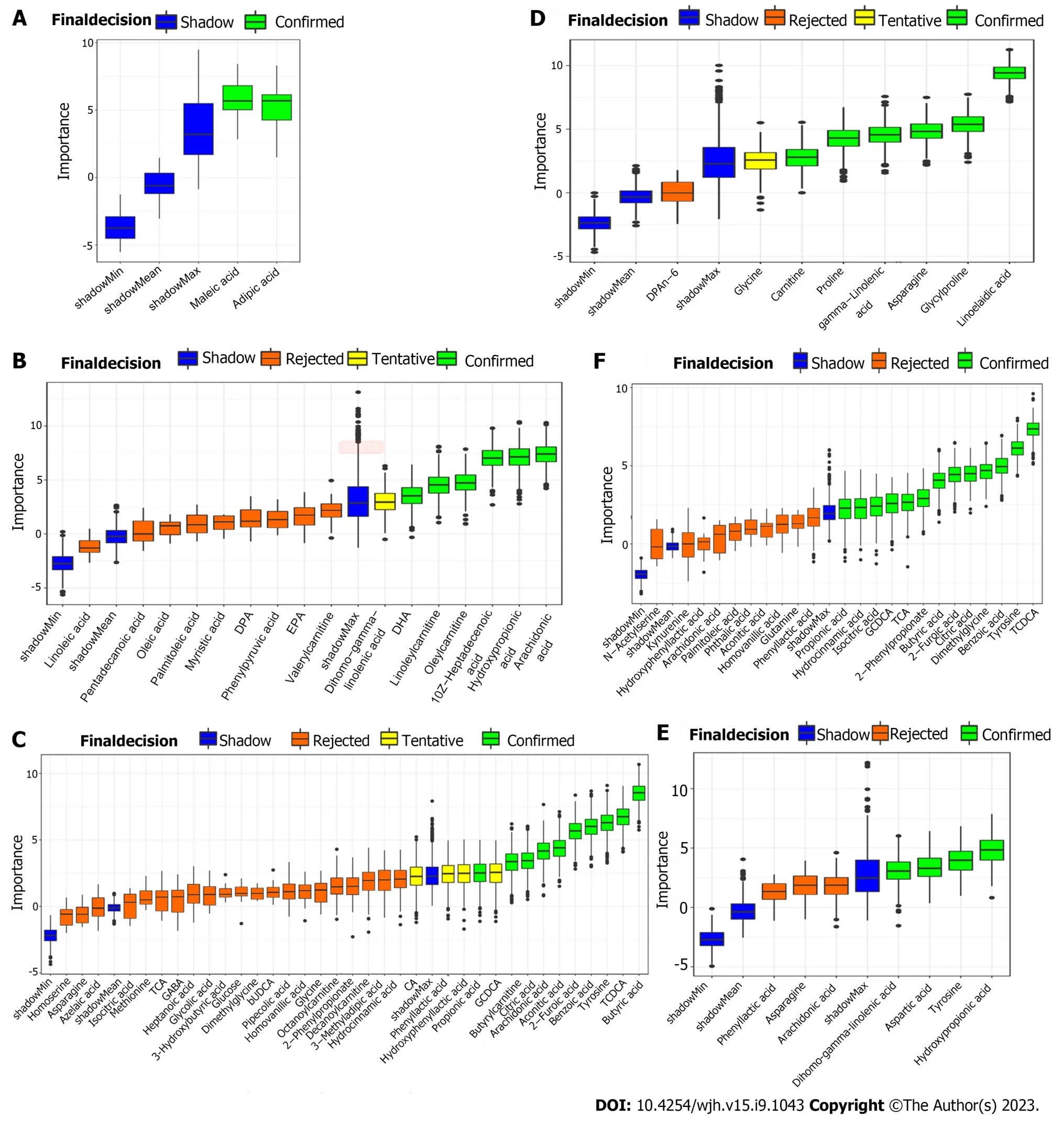
Figure 5 Boxplot of all the differential metabolites.A: Boxplot of entecavir responders (E-R) vs entecavir no-responders (E-N) (training set);B: Boxplot of FuzhengHuayu tablet (FZHY)+entecavir responders (F-R) vs FZHY+entecavir no-responders (F-N) (training set);C: Boxplot of patients vs volunteers (training set);D: Boxplot of E-R vs E-N (validation set);E: Boxplot of F-R vs F-N (validation set);F: Boxplot of patients vs volunteers (validation set).
The investigation into baseline differential metabolites for predicting the response to entecavir or entecavir+FZHY in HBV-related fibrotic livers has unveiled crucial insights with the potential to enhance tailored treatments for individuals.Notably,our findings indicated that specific differential metabolites,as mentioned earlier,were closely associated with the response to entecavir and entecavir+FZHY in HBV-related fibrotic livers.Furthermore,this study proposed that these baseline differential metabolites could be effectively combined with clinical parameters to enhance the precision of personalized treatment for patients grappling with HBV-related liver fibrosis.This approach holds the key to reducing the incidence of treatment failures stemming from inappropriate therapeutic interventions.Moreover,the insights gleaned from this research bear significant implications for the advancement of biomarker-guided precision medicine.These differential metabolites can potentially be employed to predict disease progression,select the most suitable treatment modalities,and monitor treatment outcomes among HBV patients.Additionally,this study provides a foundation for the exploration of novel metabolites or biomarkers that might serve as superior predictors of the response to entecavir or entecavir+FZHY in HBV-related fibrotic livers.Ultimately,these findings contribute to an enhanced understanding of the molecular mechanisms underpinning HBV-related liver fibrosis and may offer opportunities to more accurately evaluate the efficacy of individualized treatments.By comprehending the intricate association between these differential metabolites and the response to entecavir and entecavir+FZHY,healthcare practitioners can fine-tune treatment options for each patient,thereby optimizing the effectiveness of HBV-related liver fibrosis therapy.Furthermore,the outcomes of this study can serve as a valuable resource for the development of future pharmacological treatments that target different pathways more effectively in combatting HBV-related liver fibrosis.
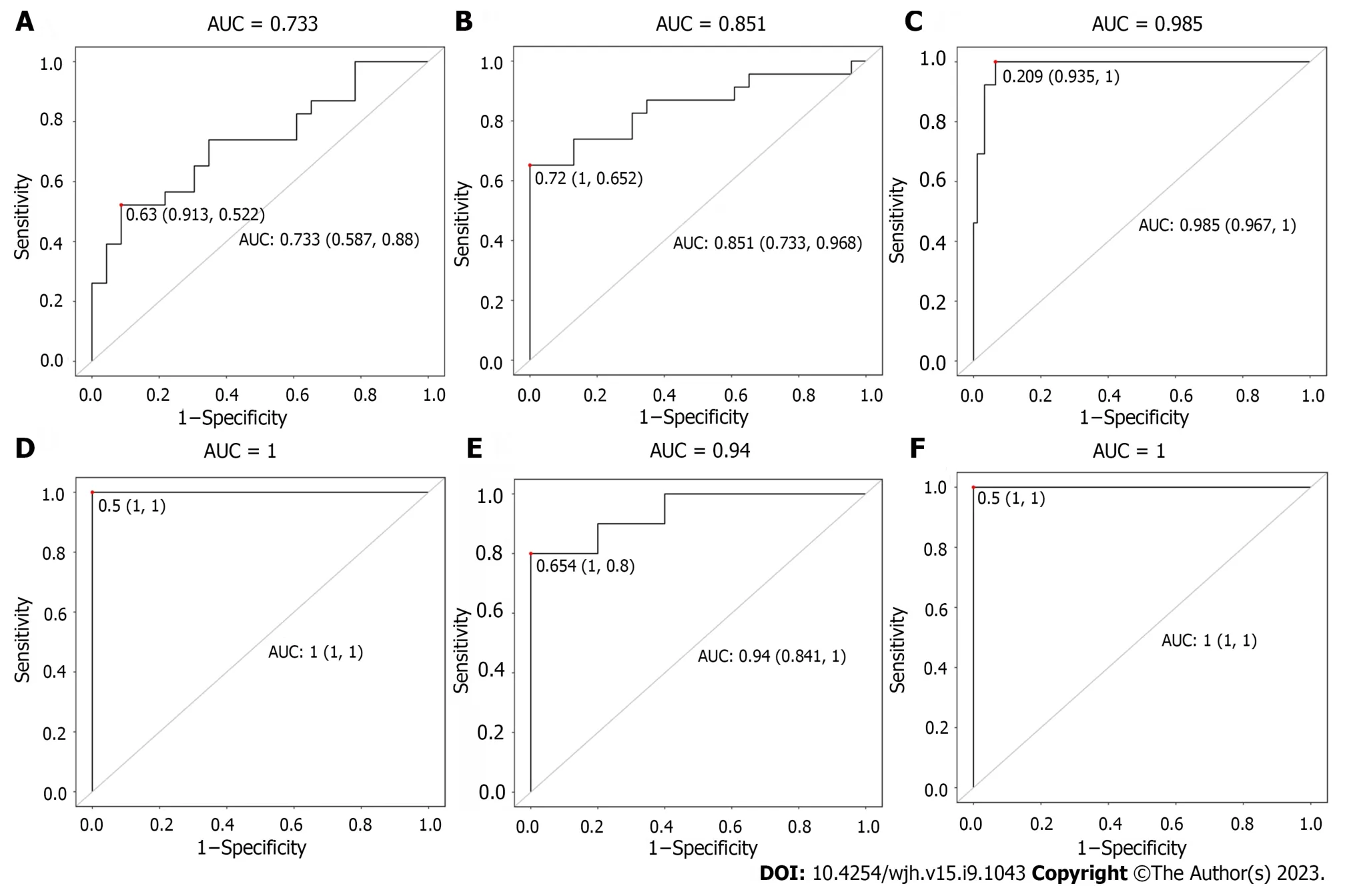
Figure 6 Receiver operating characteristic curve of all the differential metabolites.A: Receiver operating characteristic (ROC) curve of entecavir responders (E-R) vs entecavir no-responders (E-N) (training set);B: ROC curve of FuzhengHuayu tablet (FZHY)+entecavir responders (F-R) vs FZHY+entecavir no-responders (F-N) (training set);C: ROC curve of patients vs volunteers (training set);D: ROC curve of E-R vs E-N (validation set);E: ROC curve of F-R vs F-N(validation set);F: ROC curve of patients vs volunteers (validation set).AUC: Area under the curve.
There are several noteworthy limitations in our study.Firstly,all of our sample sources were confined to China.This geographically limited distribution could potentially restrict the broader applicability of our therapeutic regimen.Secondly,there was no dedicated FZHY monotherapy group.Given that all participants included in our study were CHB patients,and the development of liver fibrosis in these individuals was directly or indirectly attributed to HBV infection,antiviral therapy was considered the foundational treatment.Administering FZHY as the sole treatment to HBV-related liver fibrosis patients would be ethically inconsistent with clinical standards.Consequently,we lacked an observation of the therapeutic efficacy of FZHY in isolation.In regard to the FZHY monotherapy group,for future research endeavors,it may be considered to further validate the identified differential metabolites and metabolic pathways by selecting alternative etiologies of liver fibrosis for validation or by investigating the distinctions between monotherapy and combination therapy in animal experiments.Thirdly,our study exclusively focused on patients with hepatitis B,and whether our conclusions can be extrapolated to the treatment of liver fibrosis arising from other causes necessitates further exploration.Lastly,due to the cross-sectional nature of our study,external reproducibility should be further evaluated through prospective studies.
CONCLUSION
In summary,through metabolomis analysis,we have identified 4 metabolic pathways and 7 differential metabolites from serum that accurately differentiated responders from no-responders in the treatment of HBV-related liver fibrosis.If validated in future studies,these metabolic pathways and differential metabolites will be useful in improving the curative effect of entecavir+FZHY and promoting the development of precision medicine.
ARTICLE HIGHLIGHTS
Research background
After receiving entecavir or combined with FuzhengHuayu tablet (FZHY) treatment,some sufferers with hepatitis B virus(HBV)-related liver fibrosis could achieve a histological improvement while the others may fail to improve even worsen.Serum metabolomics at baseline in these patients who were effective in treatment remain unclear.
Research motivation
The key significance of this cross-sectional study is to predict the serum metabolites of the treatment (entecavir or entecavir+FZHY) that effectively reversed HBV-related liver fibrosis.
Research objectives
We are about to explore serum differential metabolites and metabolic pathways at baseline in HBV-related liver fibrosis patients who are response to the treatments.
Research methods
A total of 132 patients with HBV-related liver fibrosis and 18 volunteers as healthy controls were recruited.First,all subjects were divided into training set and validation set.Second,the included patients were subdivided into entecavir responders (E-R),entecavir no-responders (E-N),FZHY+entecavir responders (F-R),and FZHY+entecavir noresponders (F-N) following the pathological histological changes after 48 wk’ treatments.Then,serum samples of all subjects before treatment were tested by high-performance liquid chromatography-tandem mass spectrometry.Data processing was conducted using multivariate principal component analysis and orthogonal partial least squares discriminant analysis.Diagnostic tests of selected differential metabolites were used for Boruta analyses and logistic regression.
Research results
As for the intersection about differential metabolic pathways between the groups E-RvsE-N and F-RvsF-N,results showed that 4 pathways including Linoleic acid metabolism,aminoacyl-tRNA biosynthesis,cyanoamino acid metabolism,alanine,aspartate and glutamate metabolism were screened out.As for the differential metabolites,these 7 intersected metabolites including hydroxypropionic acid,tyrosine,citric acid,taurochenodeoxycholic acid,benzoic acid,2-furoic acid,and propionic acid were selected.
Research conclusions
Our findings showed that 4 metabolic pathways and 7 differential metabolites have potential usefulness in clinical prediction of the response of entecavir or combined with FZHY on HBV fibrotic liver.
Research perspectives
It is of great theoretical and practical significance to prevent the transformation of liver fibrosis to cirrhosis or even hepatocellular carcinoma and reduce the social burden.
FOOTNOTES
Author contributions:Liu CH and Zhao ZM conceived and designed the study;Dai YK,Fan HN,Huang K and Sun X performed the experiment;Dai YK,Fan HN,Huang K and Sun X analyzed the data;Dai YK wrote the paper;Liu CH and Zhao ZM contributed to supervision;All authors approved the final manuscript as submitted.
Supported byNational Science and Technology Major Project,No.2014ZX10005001 and No.2018ZX10 302204;National Natural Science Foundation of China,No.81730109 and No.82 274305;Shanghai Key Specialty of Traditional Chinese Clinical Medicine,No.shslczdzk01201;China Pos.doctoral Science Foundation,No.2022M 722162;Siming Youth Fund of Shuguang Hospital Affiliated to Shanghai University of Traditional Chinese Medicine,No.SGKJ-202104.
Institutional review board statement:This study was reviewed and approved by the Ethics Committee of Shuguang Hospital Affiliated to Shanghai University of Traditional Chinese Medicine.
Informed consent statement:All study participants or their legal guardian provided informed written consent about personal and medical data collection prior to study enrolment.
Conflict-of-interest statement:We have no financial relationships to disclose.
Data sharing statement:No additional data are available.
Open-Access:This article is an open-access article that was selected by an in-house editor and fully peer-reviewed by external reviewers.It is distributed in accordance with the Creative Commons Attribution NonCommercial (CC BY-NC 4.0) license,which permits others to distribute,remix,adapt,build upon this work non-commercially,and license their derivative works on different terms,provided the original work is properly cited and the use is non-commercial.See: https://creativecommons.org/Licenses/by-nc/4.0/
Country/Territory of origin:China
ORCID number:Yun-Kai Dai 0000-0002-1667-4670;Hai-Na Fan 0000-0002-5565-4875;Kai Huang 0000-0002-7294-8015;Xin Sun
0000 0001 5480 8062;Zhi-Min Zhao 0000-0002-0424-6089;Cheng-Hai Liu 0000-0002-1696-6008.
S-Editor:Qu XL
L-Editor:A
P-Editor:Cai YX
杂志排行
World Journal of Hepatology的其它文章
- Corrected QT interval in cirrhosis: A systematic review and metaanalysis
- Liver transplant in patients with primary sclerosing cholangitis: A retrospective cohort from Northeastern Brazil
- Toxicity of targeted anticancer treatments on the liver in myeloproliferative neoplasms
- Noninvasive prognostic models,imaging,and elastography to predict clinical events in primary sclerosing cholangitis: A review
